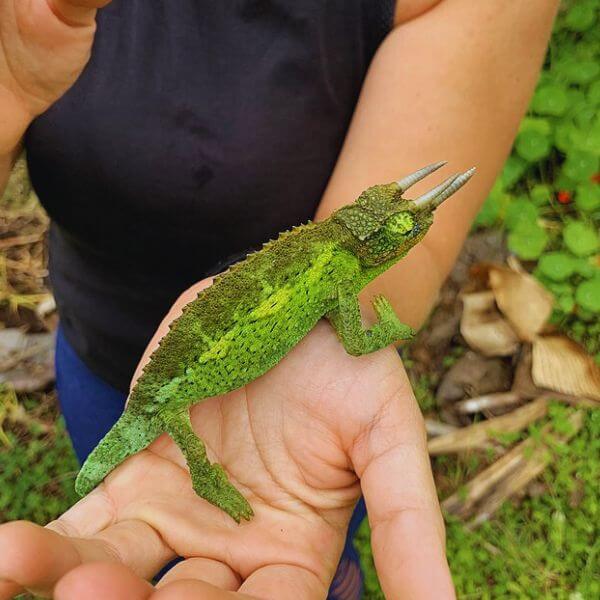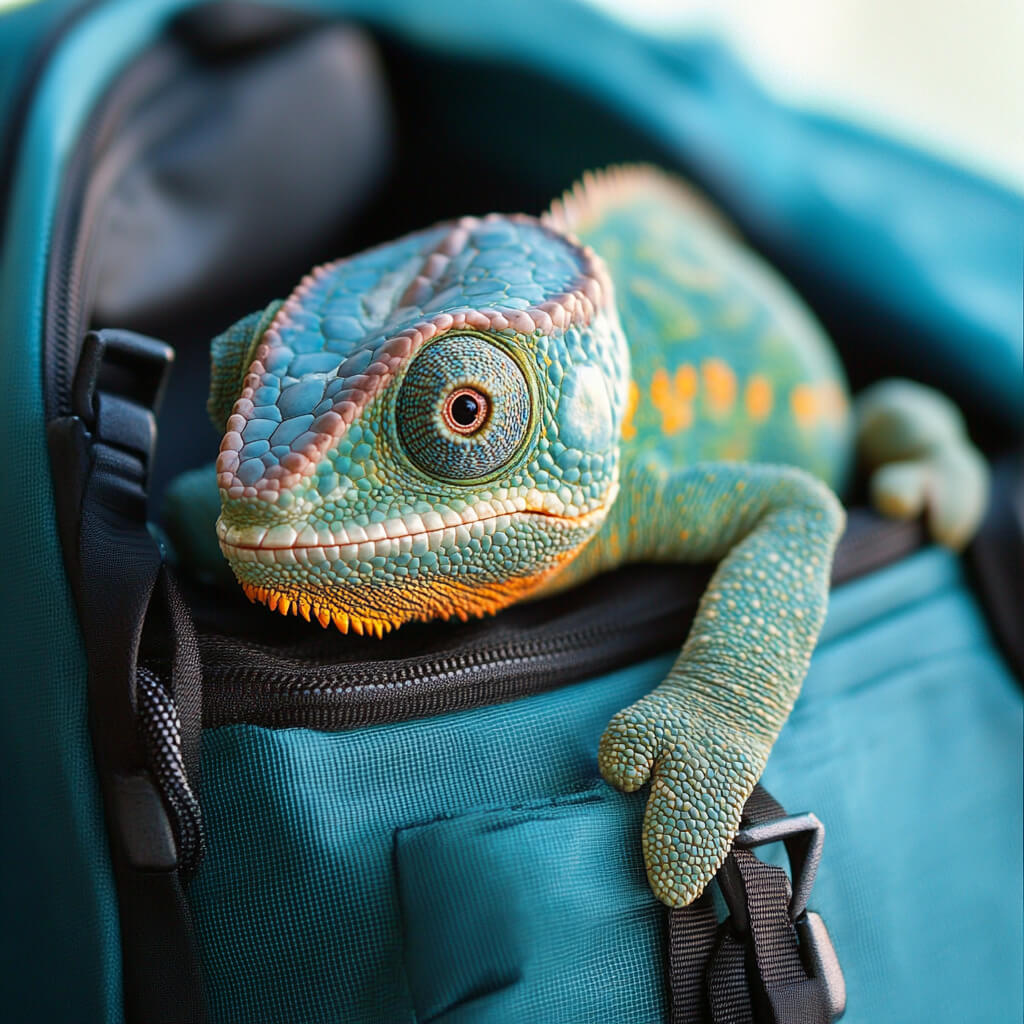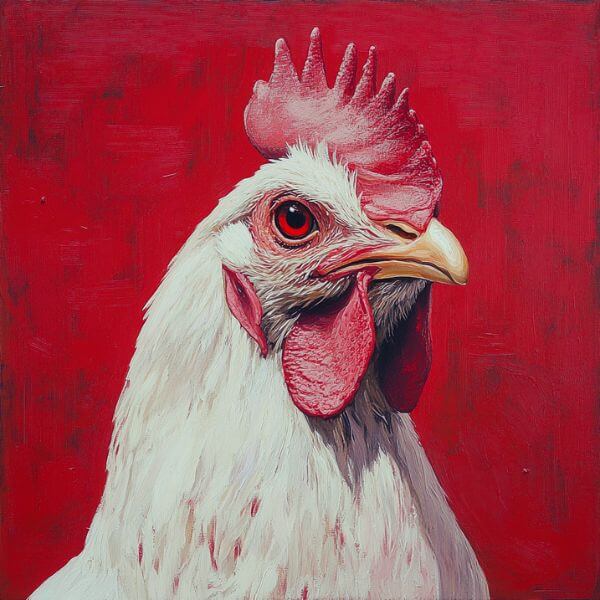Jackson’s chameleons are pretty special lizards as pets.
They’re named after Frederick John Jackson, who was an explorer and the first person to find them in the wild.
These little guys come from East Africa, specifically Kenya and Tanzania.
In the wild, they hang out in cool, moist forests.
Here are some fun facts about Jackson’s chameleons:
- They have three horns on their head (if they’re boys)
- Their eyes can move independently of each other
- They can change colors based on mood, temperature, and surroundings
- They have super long tongues that can be twice their body length
| Feature | Description |
| Scientific name | Trioceros jacksonii |
| Origin | East Africa |
| Habitat | Cool, moist forests |
| Special traits | Three horns, independent eye movement, color-changing ability |
How big do Jackson’s chameleons get?
These little lizards aren’t exactly giants. Here’s what you can expect:
- Average size: 8-10 inches long (including tail)
- Maximum size: Up to 13 inches for some big boys
- Weight: About 5-6 ounces (that’s like a small apple)
Jackson’s chameleons grow pretty quickly when they’re young. They can reach their full size in about a year. But don’t worry, they won’t outgrow your home!
How long do Jackson’s chameleons live?
If you take good care of your Jackson’s chameleon, it can be your scaly buddy for quite a while. Here’s what to expect:
- Average lifespan: 5-10 years
- Some lucky chameleons can live even longer with great care
Want your Jackson’s chameleon to live a long, happy life? Here are some tips:
- Give them a proper habitat
- Feed them a balanced diet
- Keep their stress levels low
- Take them for regular check-ups with a reptile vet
Remember, a healthy chameleon is a happy chameleon!
Setting up a cozy chameleon home habitat
Your Jackson’s chameleon needs a special home to thrive. Here’s what you’ll need:
- A tall cage (at least 2 feet high)
- Lots of branches and plants for climbing
- A drip system or misting system for humidity
- UVB lighting for vitamin D production
- Heat lamp for basking
| Item | Purpose | Estimated Cost |
| Tall cage | Living space | $100-$200 |
| Plants and branches | Climbing and hiding | $30-$50 |
| Misting system | Humidity control | $50-$100 |
| UVB light | Vitamin D production | $30-$50 |
| Heat lamp | Temperature regulation | $20-$40 |
Total estimated cost: $230-$440
Remember, these are just estimates. Prices can vary depending on where you shop and the quality of the items you choose.
What do Jackson’s chameleons eat?
Jackson’s chameleons are insectivores, which means they munch on bugs. Here’s what’s on the menu:
- Crickets (their favorite!)
- Roaches
- Mealworms
- Waxworms (as a treat)
Feed your adult chameleon 5-7 insects every other day. Young chameleons need to eat every day. Always dust the insects with calcium powder before feeding.
Pro tip: Gut-load the insects by feeding them nutritious foods before giving them to your chameleon. It’s like a vitamin boost for your scaly friend!
Keeping your Jackson’s chameleon healthy
Like all pets, Jackson’s chameleons can get sick. Here are some common health issues to watch out for:
- Metabolic bone disease (from lack of calcium or UVB light)
- Respiratory infections (from too much humidity)
- Eye infections
- Parasites
| Health Issue | Symptoms | Prevention |
| Metabolic bone disease | Soft bones, tremors, lethargy | Proper diet and UVB lighting |
| Respiratory infections | Wheezing, bubbles from nose | Proper humidity and temperature |
| Eye infections | Swollen eyes, discharge | Clean habitat, proper humidity |
| Parasites | Weight loss, lethargy | Regular vet check-ups, clean habitat |
If you notice any of these symptoms, take your chameleon to a reptile vet right away!
Check out other Chameleon Species
Handling your Jackson’s chameleon
Jackson’s chameleons can be a bit shy. They’re not big fans of being handled.
But with patience and gentle care, you can build trust with your scaly friend. Here are some tips:
- Move slowly and calmly around your chameleon
- Let them climb onto your hand instead of grabbing them
- Support their whole body when holding them
- Keep handling sessions short (5-10 minutes max)
- Never grab them by the tail
Remember, a stressed chameleon is an unhappy chameleon. Always prioritize their comfort over your desire to handle them.
FAQs about Jackson’s chameleons
Can Jackson’s chameleons live together?
Nope! They’re solitary creatures and can get stressed or fight if housed together.
How often do Jackson’s chameleons shed?
They shed their skin every 4-6 weeks. It’s like they’re getting a whole new outfit!
Do Jackson’s chameleons need water bowls?
Not really. They prefer to drink water droplets from leaves. That’s why misting is so important!
Can Jackson’s chameleons regrow lost horns or tails?
Unfortunately, no. Once they’re gone, they’re gone for good.
Wrapping it up: Is a Jackson’s chameleon right for you?
Jackson’s chameleons can make awesome pets for the right person.
They’re fascinating to watch and care for.
But remember, they need special care and attention. Here’s a quick recap:
- They need a tall, well-equipped habitat
- Their diet is mostly insects
- They require specific temperature and humidity levels
- They’re not big on handling
- They can live for 5-10 years with proper care
If you’re ready for the commitment and have the time and resources to care for these unique lizards, a Jackson’s chameleon could be your perfect scaly companion. Happy chameleon keeping!
Remember, every Jackson’s chameleon is unique, just like you!
Share your chameleon care experiences and tips with other reptile lovers.
Together, we can make the world a better place for these amazing creatures, one happy Jackson’s chameleon at a time!







Leave a Reply